cruise control CHEVROLET TAHOE 1995 1.G Owners Manual
[x] Cancel search | Manufacturer: CHEVROLET, Model Year: 1995, Model line: TAHOE, Model: CHEVROLET TAHOE 1995 1.GPages: 486, PDF Size: 27.22 MB
Page 106 of 486
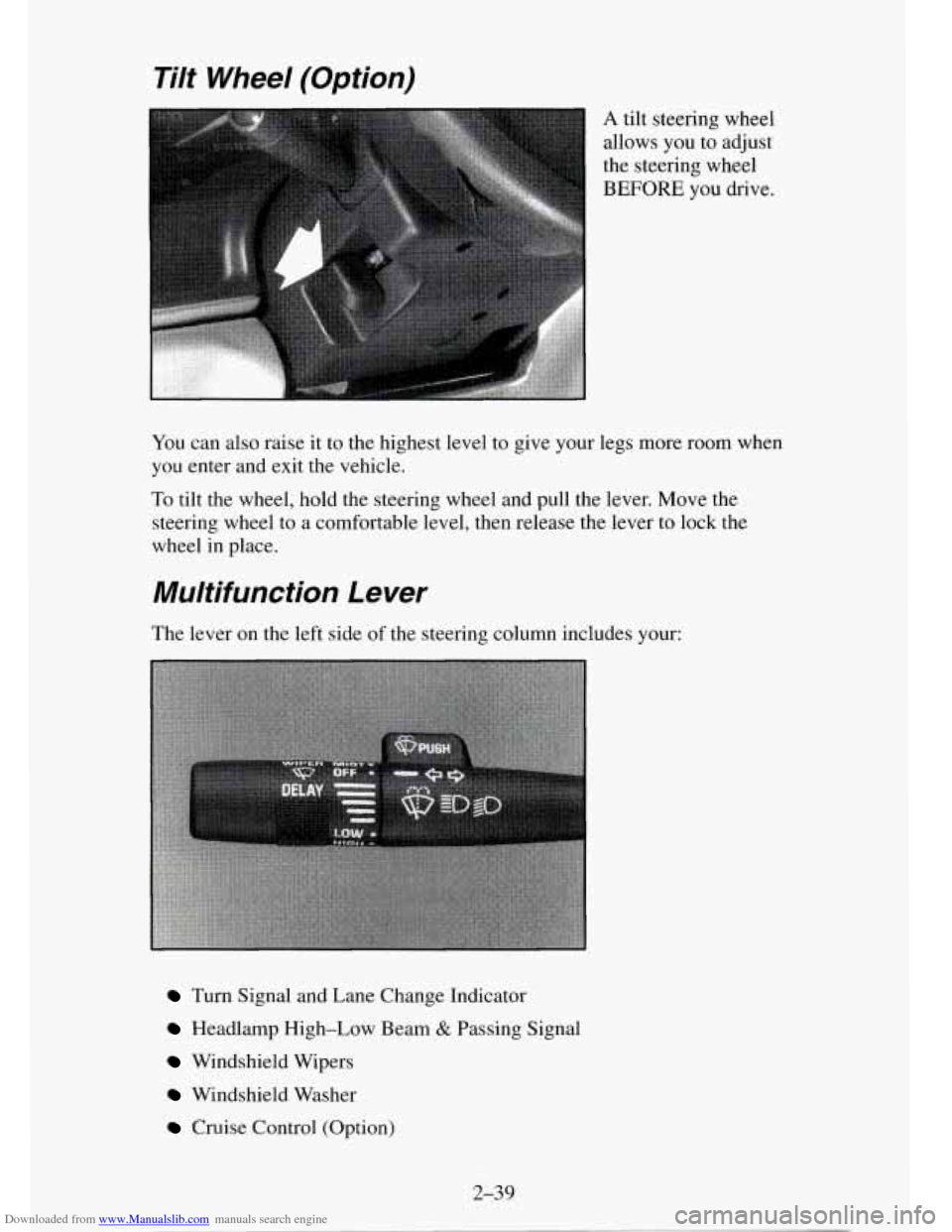
Downloaded from www.Manualslib.com manuals search engine Tilt Wheel (Option)
A tilt steering wheel
allows you to adjust
the steering wheel
BEFORE you drive.
You can also raise it to the highest level
to give your legs more room when
you enter and exit the vehicle.
To tilt the wheel, hold the steering wheel and pull the lever. Move the
steering wheel to a comfortable level, then release the lever to lock the
wheel in place.
Multifunction Lever
The lever on the left side of the steering column includes your:
Turn Signal and Lane Change Indicator
Headlamp High-Low Beam & Passing Signal
Windshield Wipers
Windshield Washer
Cruise Control (Option)
2-39
I
Page 110 of 486
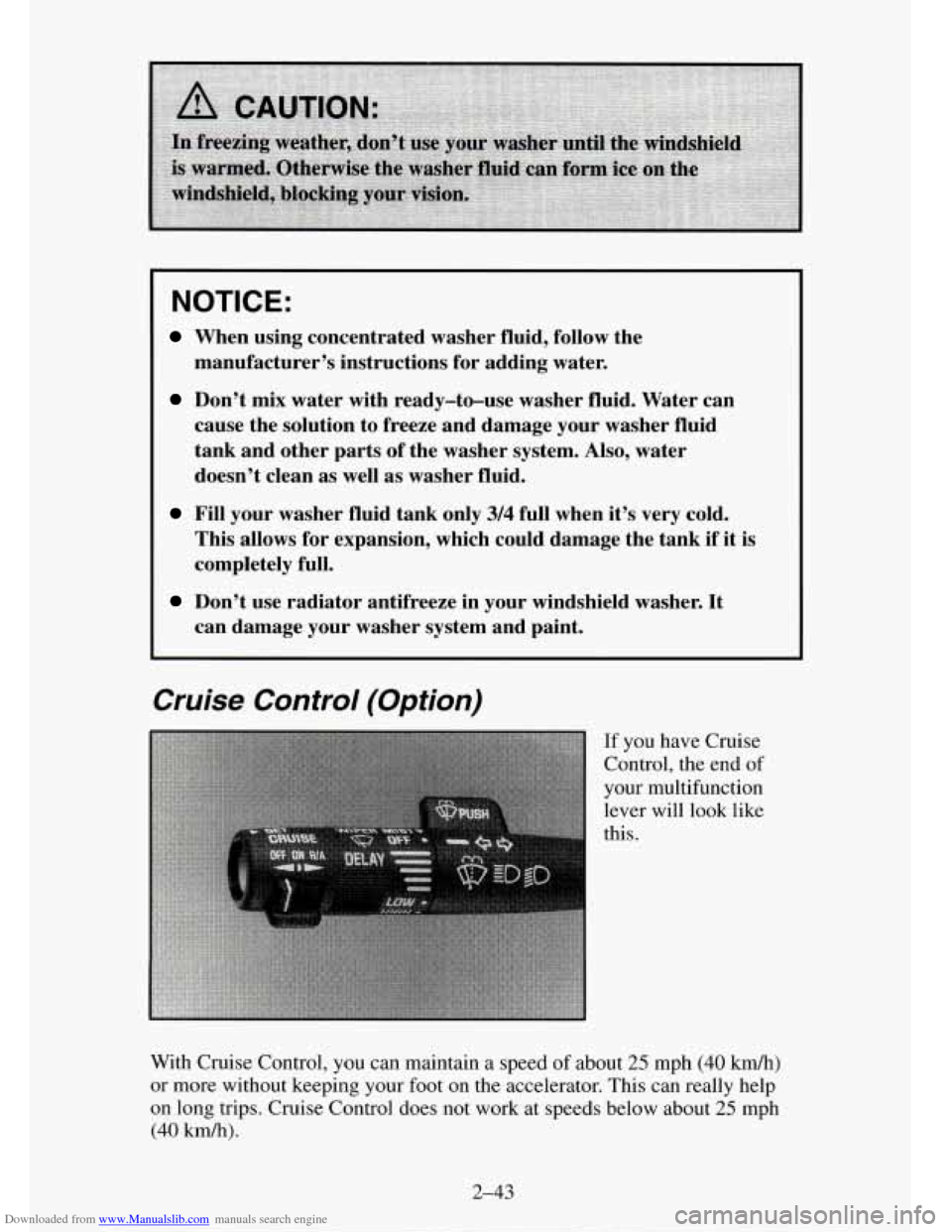
Downloaded from www.Manualslib.com manuals search engine NOTICE:
When using concentrated washer fluid, follow the
manufacturer’s instructions for adding water.
Don’t mix water with ready-to-use washer fluid. Water can
cause the solution to freeze and damage your washer fluid
tank and other parts of the washer system. Also, water
doesn’t clean
as well as washer fluid.
Fill your washer fluid tank only 3/4 full when it’s very cold.
This allows for expansion, which could damage the tank
if it is
completely full.
Don’t use radiator antifreeze in your windshield washer. It
can damage your washer system and paint.
Cruise Control (Option)
’ If you have Cruise
Control, the end
of
your multifunction lever will look like
this.
With Cruise Control, you can maintain a speed of about 25 mph (40 km/h)
or more without keeping your foot on the accelerator. This can really help
on long trips. Cruise Control does
not work at speeds below about 25 mph
(40 km/h).
2-43
Page 111 of 486
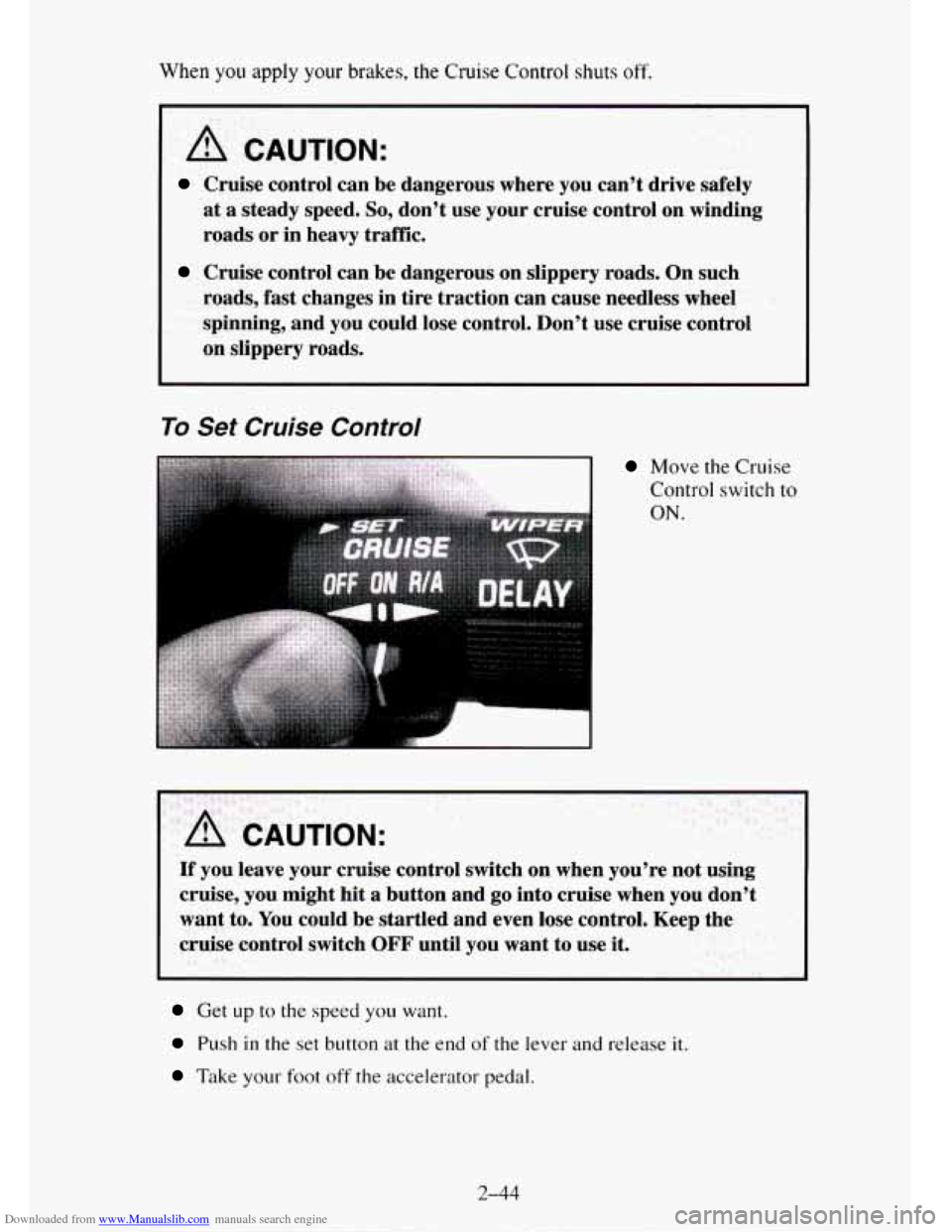
Downloaded from www.Manualslib.com manuals search engine When you apply your brakes, the Cruise Control shuts off.
A CAUTION:
Cruise control can be dangerous where you can’t drive safely
at a steady speed. So, don’t use your cruise control on winding
roads or in heavy traffic.
Cruise control can be dangerous on slippery roads. On such
roads, fast changes in tire traction can cause needless wheel
spinning, and you could lose control. Don’t use cruise control
on slippery roads.
To Set Cruise Control
I Move the Cruise
Control switch
to
ON.
If you leave your cruise control switch on when you’re not using
cruise, you might hit
a button and go into cruise when you don’t
want to. You could be startled and even lose control. Keep the
cruise control switch
OFF until you want to use it.
Get up to the speed you want.
Push in the set button at the end of the lever and release it.
Take your foot off the accelerator pedal.
2-44
Page 112 of 486
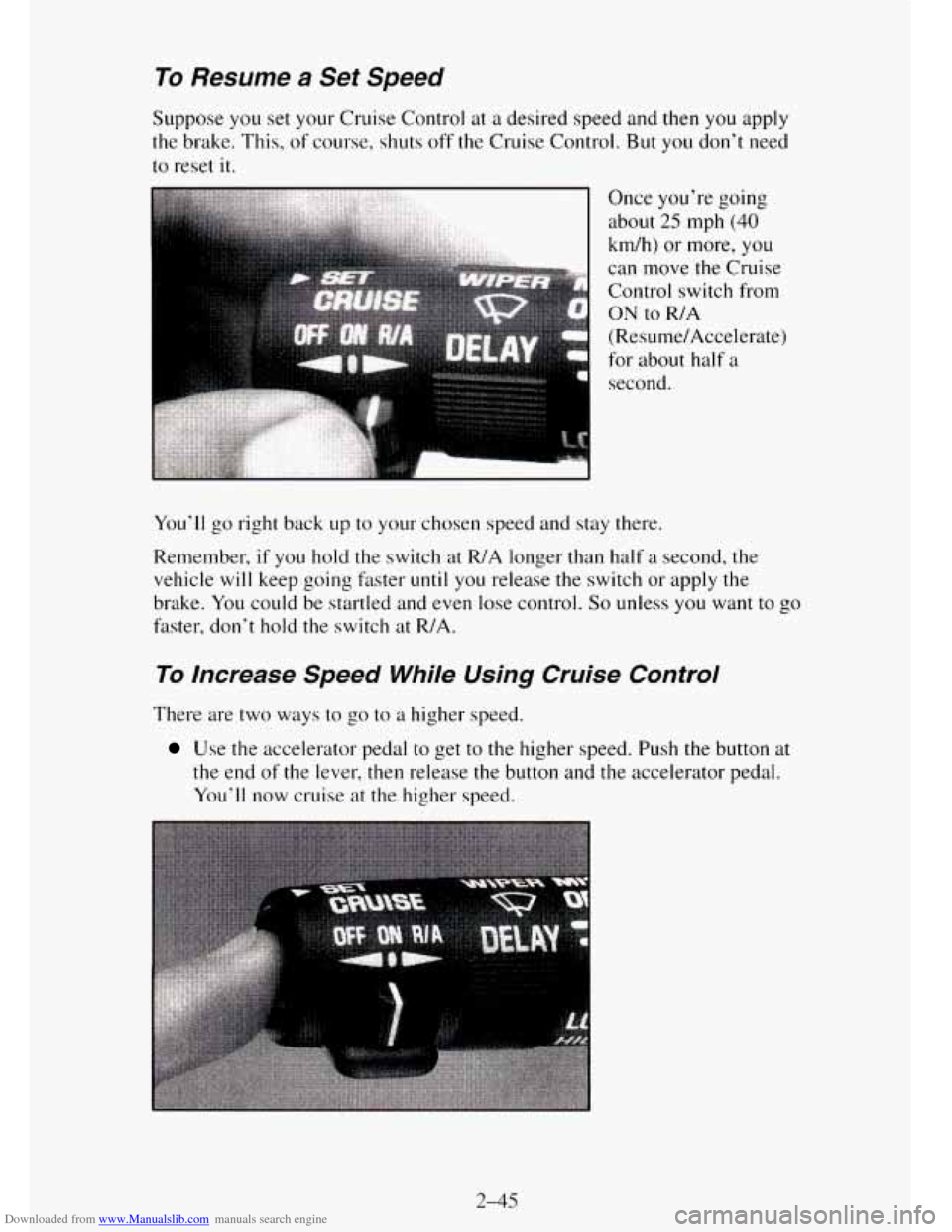
Downloaded from www.Manualslib.com manuals search engine To Resume a Set Speed
Suppose you set your Cruise Control at a desired speed and then you apply
the brake.
This, of course, shuts off the Cruise Control. But you don’t need
to reset it.
Once you’re going
about
25 mph (40
km/h) or more, you
can move the Cruise
Control switch from
ON to R/A
(Resume/Accelerate)
for about half
a
1 second.
You’ll go right back up to your chosen speed and stay there.
Remember,
if you hold the switch at R/A longer than half a second, the
vehicle will keep going
fater until you release the switch or apply the
brake. You could be startled and even lose control.
So unless you want to go
faster, don’t hold the switch at R/A.
To Increase Speed While Using Cruise Control
There are two ways to go to a higher speed.
Use the accelerator pedal to get to the higher speed, Push the button at
the end of the lever, then release the button and the accelerator pedal.
You’ll now cruise at the higher speed.
2-45
Page 113 of 486
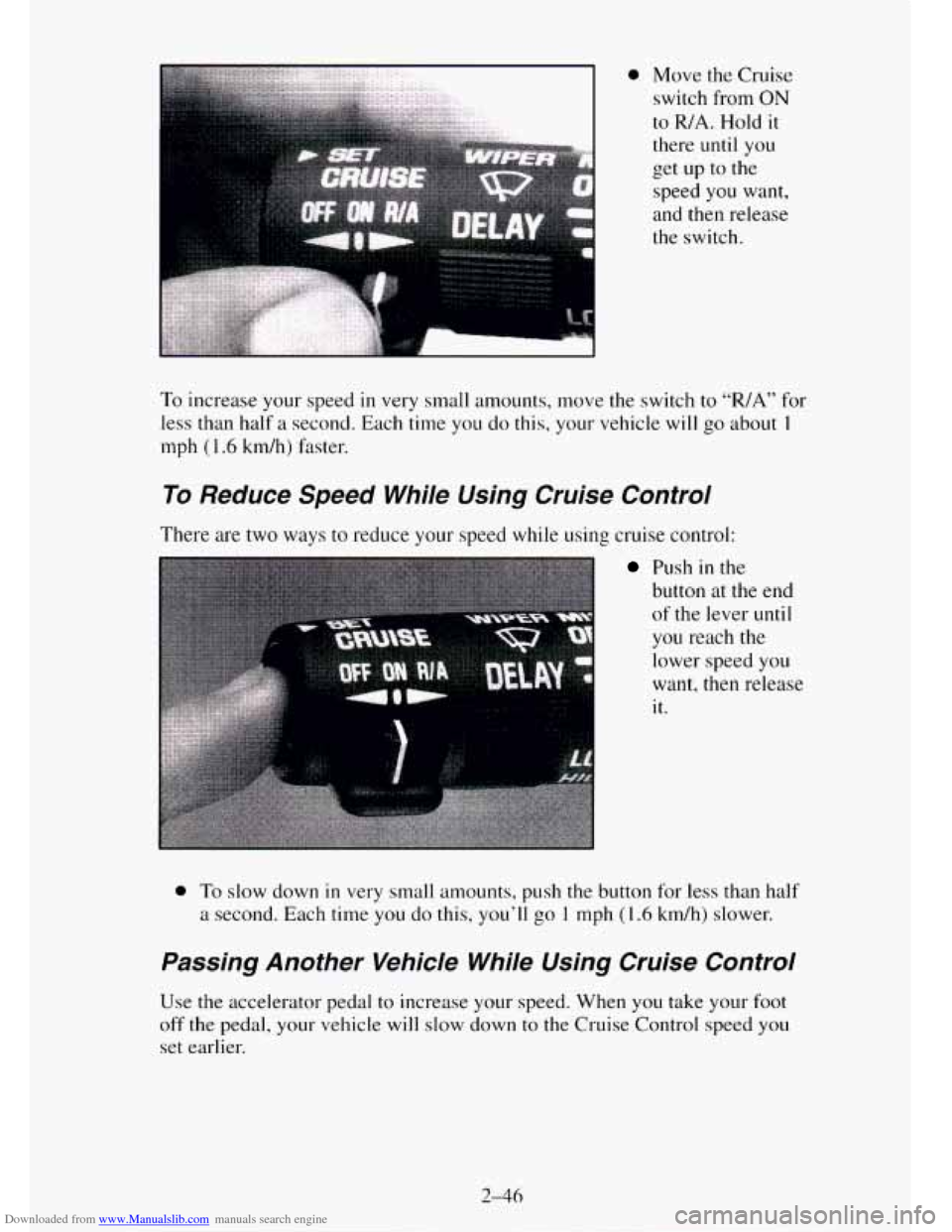
Downloaded from www.Manualslib.com manuals search engine the switch.
To increase your speed in very small amounts, move the switch to “R/A” for
less than half a second. Each time
you do this, your vehicle will go about I
mph (1.6 kdh) faster.
To Reduce Speed While Using Cruise Control
There are two ways to reduce your speed while using cruise control:
Push in the
button at the end
of the lever until
you reach the
lower speed you
want, then release
it.
0 To slow down in very small amounts, push the button for less than half
a second. Each time you do this, you’ll
go I mph (1.6 km/h) slower.
Passing Another Vehicle While Using Cruise Control
Use the accelerator pedal to increase your speed. When you take your foot
off the pedal, your vehicle will slow down
to the Cruise Control speed you
set earlier.
2-46
Page 114 of 486
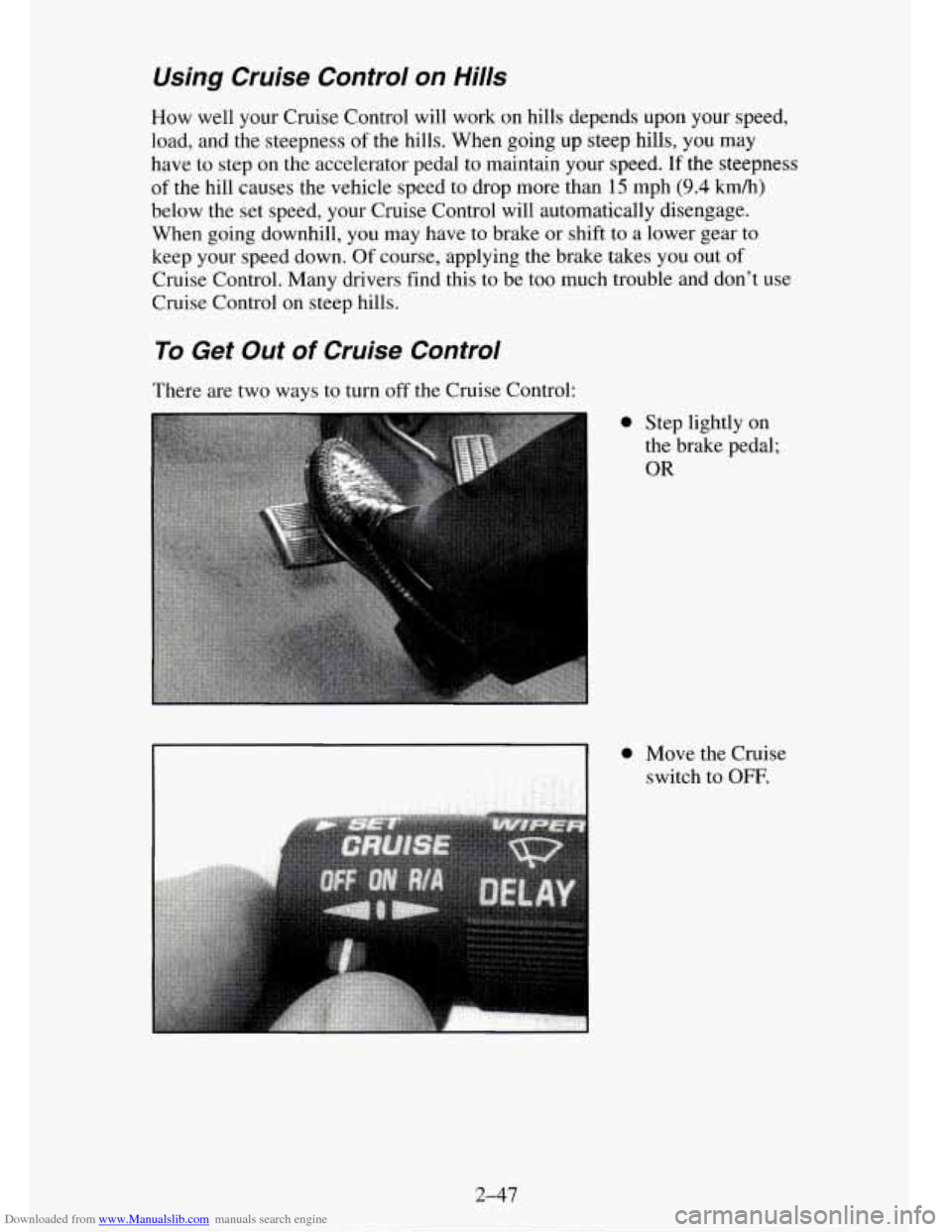
Downloaded from www.Manualslib.com manuals search engine Using Cruise Control on Hills
How well your Cruise Control will work on hills depends upon your speed,
load, and the steepness
of the hills. When going up steep hills, you may
have
to step on the accelerator pedal to maintain your speed. If the steepness
of the hill causes the vehicle speed to drop more than 15 mph (9.4 km/h)
below the set speed, your Cruise Control will automatically disengage.
When going downhill, you may have to brake or shift to
a lower gear to
keep your speed down. Of course, applying the brake takes you out
of
Cruise Control. Many drivers find this to be too much trouble and don’t use
Cruise Control on steep hills.
To Get Out of Cruise Control
There are two ways to turn off the Cruise Control:
0 Step lightly on
the brake pedal;
OR
2-47
Page 115 of 486
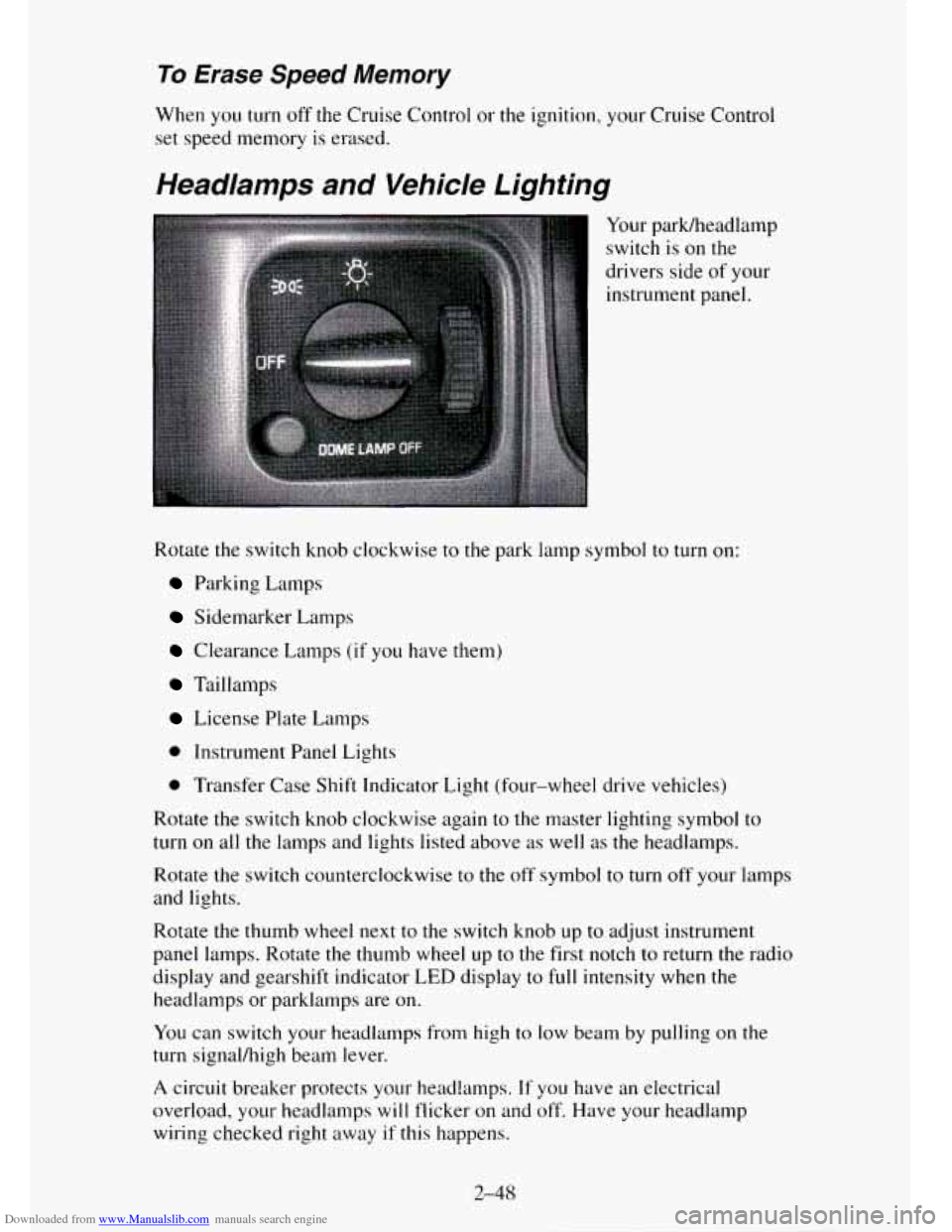
Downloaded from www.Manualslib.com manuals search engine To Erase Speed Memory
When you turn off the Cruise Control or the ignition, your Cruise Control
set speed memory
is erased.
Headamps and Vehicle Lighting
Your parWheadlamp
switch
is on the
drivers side
of your
instrument panel.
Rotate
the switch knob clockwise to the park lamp symbol to turn on:
Parking Lamps
Sidemarker Lamps
Clearance Lamps (if you have them}
Taillamps
License Plate Lamps
0 Instrument Panel Lights
0 Transfer Case Shift Indicator Light (four-wheel drive vehicles)
Rotate
the switch knob clockwise again to the master lighting symbol to
turn on all the lamps and lights listed above as well as the headlamps.
Rotate the switch counterclockwise to the off sylnbol to turn
off your lamps
and lights.
Rotate the thumb wheel
next to the switch knob up to adjust instrument
panel lamps. Rotate the thumb wheel up to the first notch to return
the radio
display and gearshift indicator LED display
to full intensity when the
headlamps or parklamps are on.
You can switch your headlamps from high to low beam by pulling on the
turn signal/high beam lever.
A circuit breaker protects your headlamps. If you have an electrical
overload, your headlamps
will flicker on and off. Have your headlamp
wiring checked right away
if this happens.
2-48
Page 358 of 486
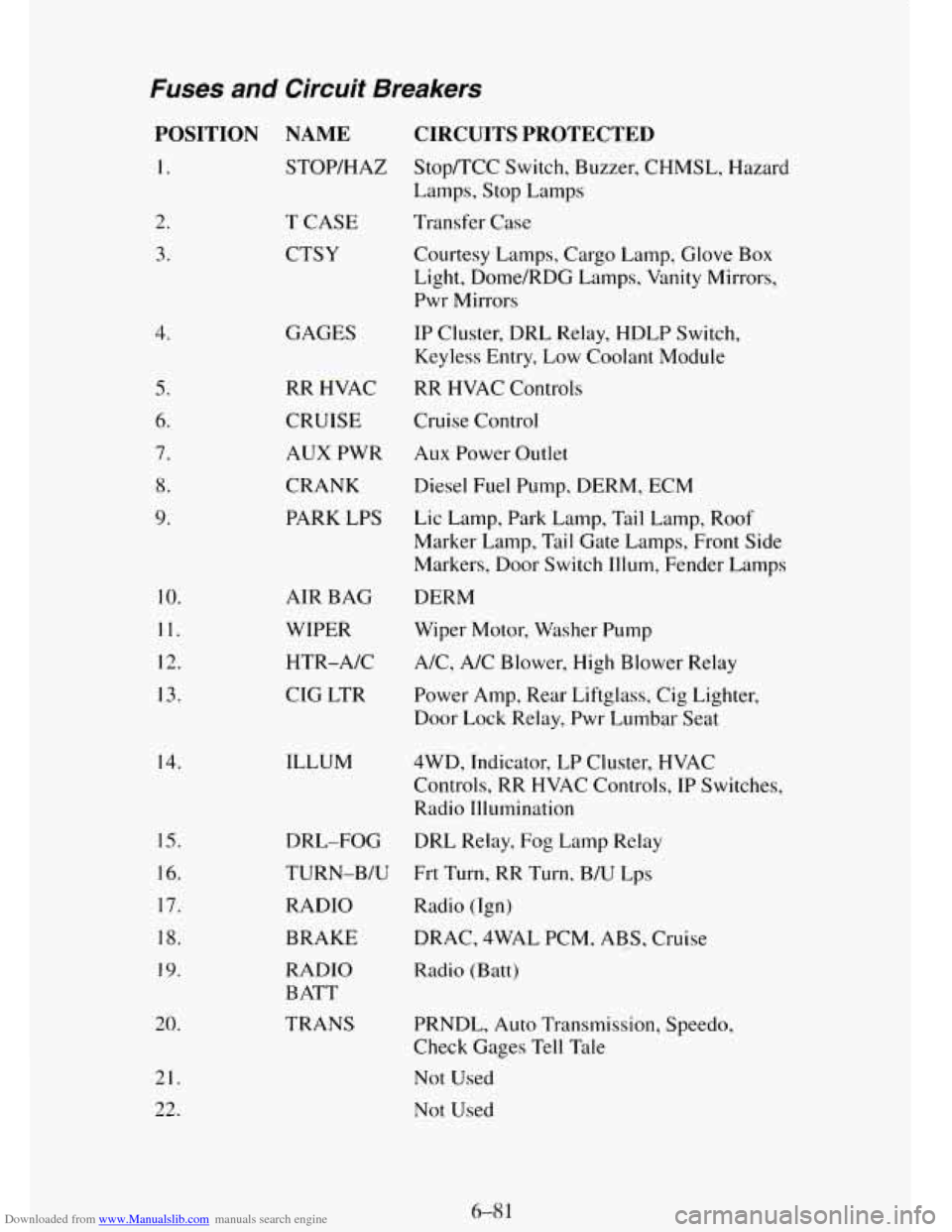
Downloaded from www.Manualslib.com manuals search engine Fuses and Circuit Breakers
POSITION
1.
2.
3.
4.
5.
6.
7.
8.
9.
10.
11.
12.
13. 14.
15.
16.
17.
18.
19.
20.
21.
22.
NAME
STOP/HAZ
T CASE
CTSY
GAGES
RR WAC
CRUISE
AUX PWR CRANK
PARK LPS
AIR BAG
WIPER
HTR-A/C
CIG LTR
ILLUM
DRL-FOG
TURN-B/U
RADIO
BRAKE
RADIO
BATT
TRANS
CIRCUITS PROTECTED
Stop/TCC Switch, Buzzer, CHMSL, Hazard
Lamps, Stop Lamps
Transfer Case
Courtesy Lamps, Cargo Lamp, Glove Box
Light, Dome/RDG Lamps, Vanity Mirrors,
Pwr Mirrors
IP Cluster, DRL Relay, HDLP Switch,
Keyless Entry, Low Coolant Module
RR HVAC Controls
Cruise Control
Aux Power Outlet
Diesel Fuel Pump, DERM, ECM
Lic Lamp, Park Lamp, Tail Lamp, Roof
Marker Lamp, Tdi1 Gate Lamps, Front Side
Markers, Door Switch Illum, Fender Lamps
DERM
Wiper
Motor, Washer Pump
A/C, A/C Blower, High Blower Relay
Power Amp, Rear Liftglass, Cig Lighter,
Door Lock Relay, Pwr Lumbar Seat
4WD, Indicator, LP Cluster, HVAC
Controls,
RR HVAC Controls, IP Switches,
Radio Illumination
DRL Relay,
Fog Lamp Relay
Frt Turn, RR Turn, B/U Lps
Radio (Ign)
DRAC, 4WAL PCM. ABS,
... . Cruise
Radio (Batt)
PRNDL, Auto Transmission, Speedo,
Check Gages Tell Tde
Not Used Not Used
Page 459 of 486
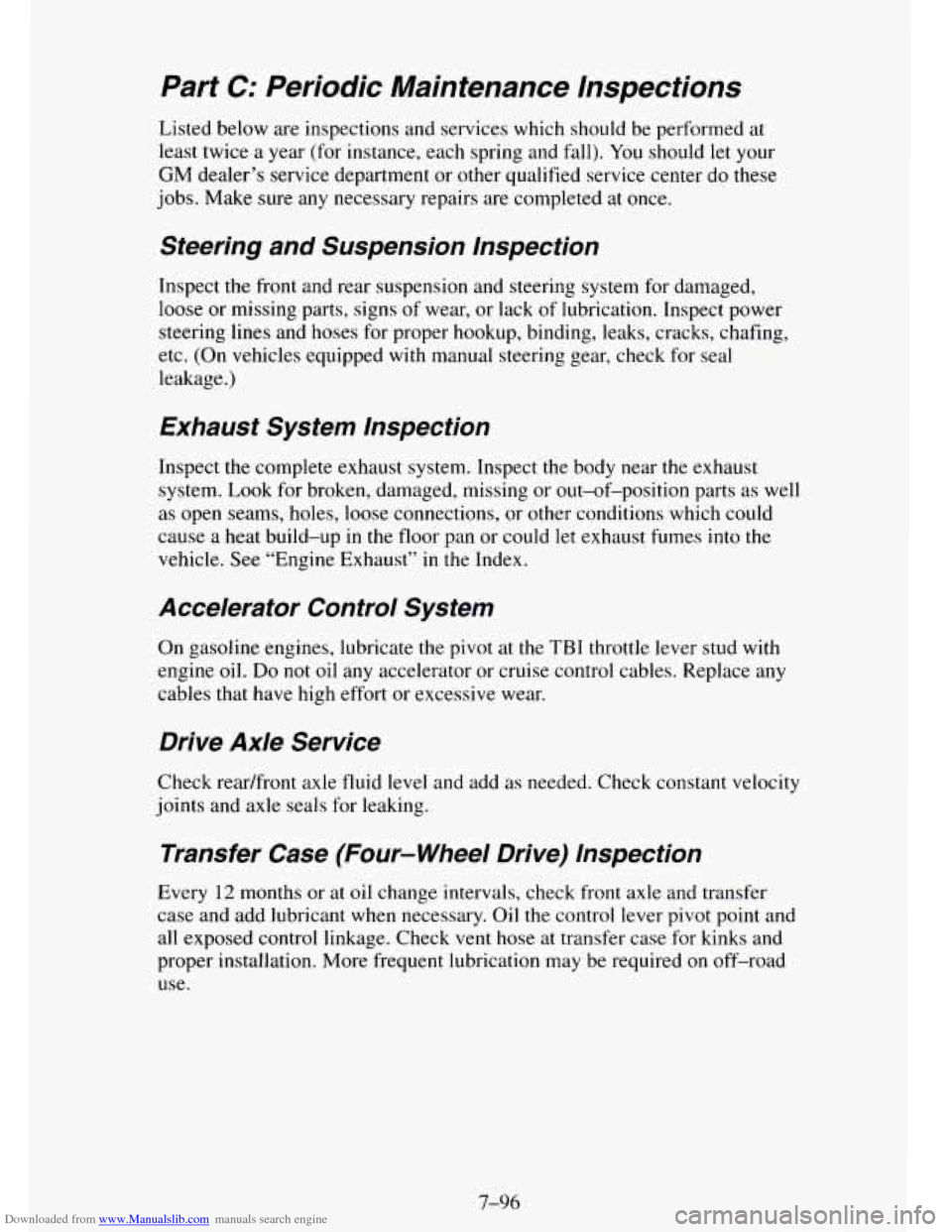
Downloaded from www.Manualslib.com manuals search engine Part C: Periodic Maintenance Inspections
Listed below are inspections and services which should be performed at
least twice a year (for instance, each spring and fall).
You should let your
GM dealer’s service department or other qualified service center do these
jobs.
Make sure any necessary repairs are completed at once.
Steering and Suspension lnspection
Inspect the front and rear suspension and steering system for damaged,
loose or missing parts, signs
of wear, or lack of lubrication. Inspect power
steering lines and hoses for proper hookup, binding, leaks, cracks, chafing,
etc. (On vehicles equipped with manual steering gear, check
for seal
leakage.)
Exhaust System lnspection
Inspect the complete exhaust system. Inspect the body near the exhaust
system.
Look for broken, damaged, missing or out-of-position parts as well
as open seams, holes, loose connections, or other conditions which could
cause
a heat build-up in the floor pan or could let exhaust fumes into the
vehicle.
See “Engine Exhaust’’ in the Index.
Accelerator Control System
On gasoline engines, lubricate the pivot at the TBI throttle lever stud with
engine oil.
Do not oil any accelerator or cruise control cables. Replace any
cables that have high effort or excessive wear.
Drive Axle Service
Check readfront axle fluid level and add as needed. Check constant velocity
joints and axle seals for leaking.
Transfer Case (Four- Wheel Drive) Inspection
Every 12 months or at oil change intervals, check front axle and transfer
case and add lubricant when necessary. Oil the control lever pivot point and
all exposed control linkage. Check vent hose
at transfer case for kinks and
proper installation. More frequent lubrication
may be required on off-road
use.
Page 476 of 486
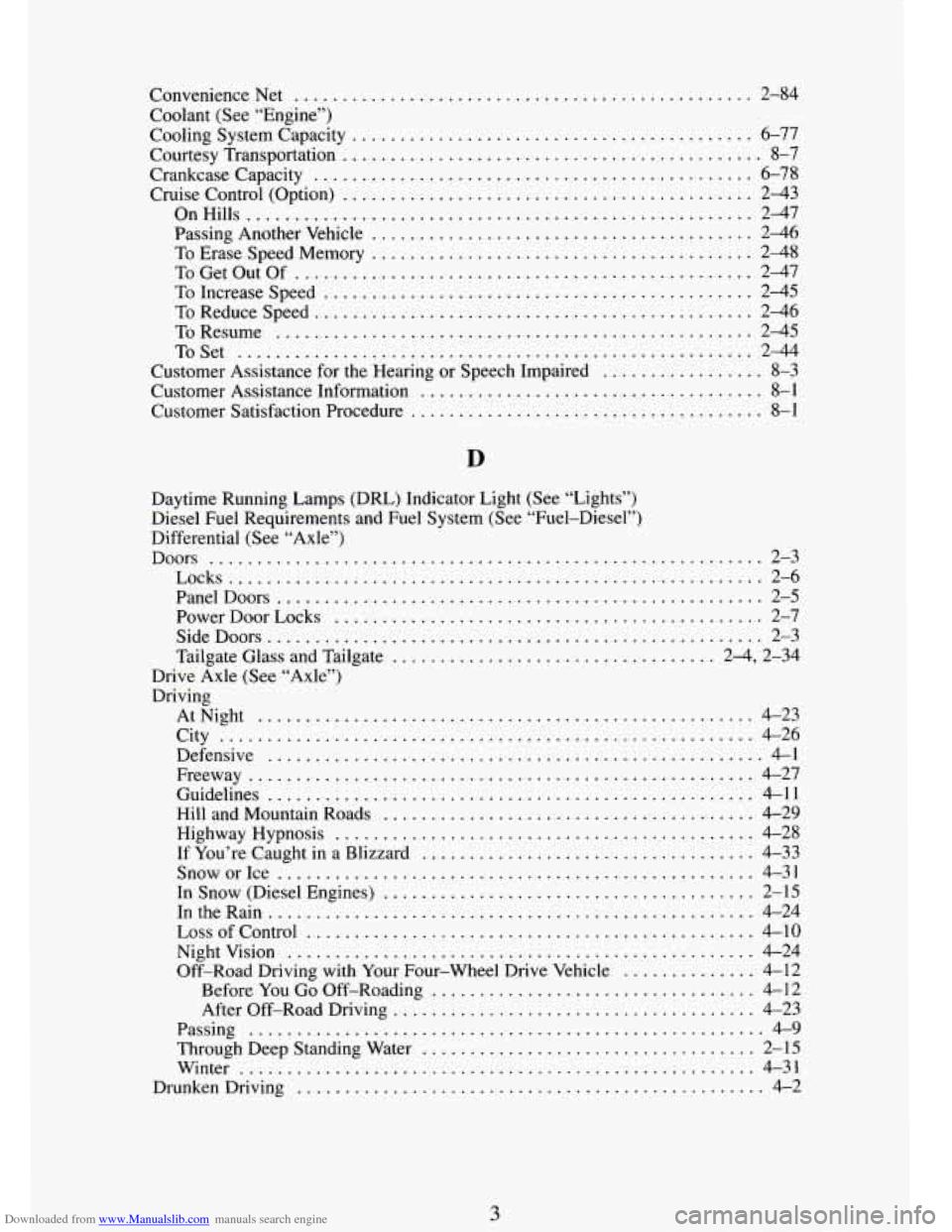
Downloaded from www.Manualslib.com manuals search engine ConvenienceNet ................................................ 2-84
Coolant (See “Engine”)
Cooling System Capacity
.......................................... 6-77
Courtesy Transportation
............................................ 8-7
Crankcase Capacity
.............................................. 6-78
Cruise Control (Option)
........................................... 2-43
OnHills ..................................................... 2-47
Passing Another Vehicle
........................................ 246
To Erase Speed Memory ........................................ 248
ToGetOutOf
................................................ 2-47
ToIncreaseSpeed
............................................. 245
ToReduceSpeed
.............................................. 2-46
ToResume
.................................................. 245
ToSet
...................................................... 244
Customer Assistance for the Hearing or Speech Impaired
................. 8-3
Customer Assistance Information
.................................... 8-1
Customer Satisfaction Procedure
................................... 8-1
Daytime Running Lamps (DRL) Indicator Light (See “Lights”)
Diesel Fuel Requirements and Fuel System (See “Fuel-Diesel”)
Differential (See “Axle”)
Doors .......................................................... 2-3
Locks
........................................................ 2-6
PanelDoors
................................................... 2-5
PowerDoorLocks
............................................. 2-7
SideDoors
.................................................... 2-3
Tailgate Glass and Tailgate
.................................. 2-4, 2-34
Drive Axle (See “Axle”)
Driving AtNight
.................................................... 4-23
City
........................................................ 4-26
Defensive
.................................................... 4-1
Freeway ..................................................... 4-27
Guidelines
................................................... 4-11
Hill and Mountain Roads
....................................... 4-29
Highway Hypnosis
............................................ 4-28
If You’re Caught in a Blizzard
................................... 4-33
SnoworIce
.................................................. 4-31
In Snow (Diesel Engines)
....................................... 2-15
IntheRain ................................................... 4-24
LossofControl
............................................... 4-10
Nightvision ................................................. 4-24
Off-Road Driving with Your Four-wheel Drive Vehicle
.............. 4-12
Before You
Go Off-Roading .................................. 4-12
After Off-Road Driving
...................................... 4-23
Passing
...................................................... 4-9
Through Deep Standing Water ................................... 2-15
Winter
...................................................... 4-31
DrunkenDriving
............................................... 4-2
3